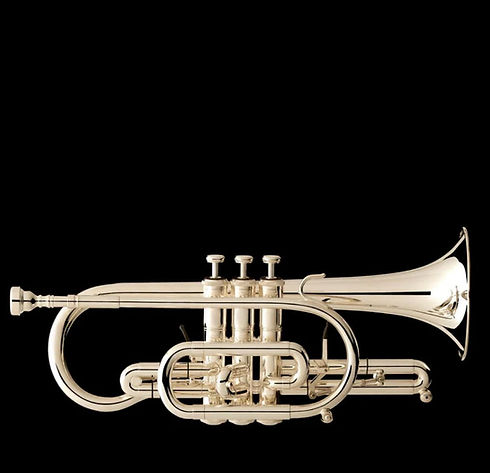

MUSIC & INSTRUMENTS

A cornet is a musical instrument that belongs to the brass family. It is similar in appearance to a trumpet, but it is shorter and more compact, with a conical bore and a slightly mellower sound. The cornet has a cup-shaped mouthpiece and three valves, which the player uses to change the pitch.
Cornets are commonly used in brass bands, jazz bands, and orchestras. They were developed in the early 19th century and became popular in the mid-1800s, particularly in military and brass bands.
The Cornet section is made up of a Principal Cornet, First, Second and Third Cornet, a Soprano Cornet and a Repiano Cornet.
A flugelhorn is a brass instrument that is similar in appearance to a trumpet but has a wider, more conical bore, and a deeper, more mellow tone. It is typically pitched in Bb and has three piston valves, like a trumpet.
The flugelhorn is often used in jazz and brass band music, and is known for its rich, warm sound that is often described as "smoky" or "velvety". It is also sometimes used in classical music and is occasionally employed as a solo instrument.

Flugelhorn
Photograph by wessex-tubas.com

The tenor horn is a brass instrument in the saxhorn family and is usually pitched in E-Flat (E♭). It has a bore that is mostly conical, like the flugelhorn and euphonium and normally uses a deep, cornet-like mouthpiece.
It is most commonly used in brass bands and Mexican banda music, and occasionally been used as an alternative to the French horn in concert bands.
The baritone horn is a low-pitched brass instrument in the saxhorn family. It is a piston-valve brass instrument with a bore that is mostly conical, like the higher pitched flugelhorn and alto (tenor) horn, but it has a narrower bore compared to the similarly pitched euphonium. It uses a wide-rimmed cup mouthpiece like that of its peers, the trombone and euphonium. Like the trombone and the euphonium, the baritone horn can be considered either a transposing or non-transposing instrument.
The baritone is part of the standardised instrumentation of brass bands. In concert band music, there is often a part marked baritone, but these parts are most commonly intended for, and played on, the euphonium. A baritone can also play music written for a trombone due to similarities in timbre and range.

Baritones
Photograph by wessex-tubas.com

A euphonium is a brass instrument that is similar in shape to a tuba but is smaller in size and has a higher range of notes. It is also sometimes called a tenor tuba.
The euphonium is a member of the brass family of instruments and is known for its mellow and rich sound. It is often used in brass bands, wind ensembles, and orchestras, and can be played both as a solo instrument and as part of an ensemble. Euphoniums typically have three or four valves that the player uses to change the pitch of the notes they play..
A trombone is a musical instrument that is part of the brass family. It is a long, cylindrical tube with a flared bell at the end and a mouthpiece at the other. The trombone is played by sliding a telescoping slide in and out, which changes the length of the tube and produces different pitches.
The player creates sound by buzzing their lips into the mouthpiece, and the resulting vibration travels through the instrument and is amplified by the bell.
The trombone is known for its distinct slide sound and is often used in orchestras, jazz bands, and other genres of music.

Trombones

The bass is commonly used in marching bands, jazz ensembles, and orchestra settings to provide a deep, rich sound.
The bass is an essential component of many musical compositions and is highly valued for its ability to add depth and richness to the overall sound of a performance.
The percussion section includes instruments such as snare drums, bass drums and cymbals, and other instruments as needed.
The snare drum is one of the most important percussion instruments in a brass band, and is often used to create the backbeat and provide rhythmic drive. Bass drums are usually used to accentuate the downbeats and provide a deeper sound to the percussion section. Cymbals are used for accents, crashes, and other special effects.
In addition to these core instruments, brass bands may also use auxiliary percussion instruments such as tambourines, maracas, and shakers to add variety and texture to their sound. The choice of percussion instruments and how they are used in a brass band often depends on the style of music being played and the preferences of the conductor and musicians.



